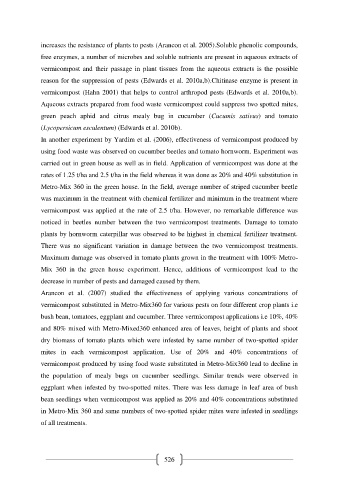Page 536 - e-Book
P. 536
increases the resistance of plants to pests (Arancon et al. 2005).Soluble phenolic compounds,
free enzymes, a number of microbes and soluble nutrients are present in aqueous extracts of
vermicompost and their passage in plant tissues from the aqueous extracts is the possible
reason for the suppression of pests (Edwards et al. 2010a,b).Chitinase enzyme is present in
vermicompost (Hahn 2001) that helps to control arthropod pests (Edwards et al. 2010a,b).
Aqueous extracts prepared from food waste vermicompost could suppress two spotted mites,
green peach aphid and citrus mealy bug in cucumber (Cucumis sativus) and tomato
(Lycopersicum esculentum) (Edwards et al. 2010b).
In another experiment by Yardim et al. (2006), effectiveness of vermicompost produced by
using food waste was observed on cucumber beetles and tomato hornworm. Experiment was
carried out in green house as well as in field. Application of vermicompost was done at the
rates of 1.25 t/ha and 2.5 t/ha in the field whereas it was done as 20% and 40% substitution in
Metro-Mix 360 in the green house. In the field, average number of striped cucumber beetle
was maximum in the treatment with chemical fertilizer and minimum in the treatment where
vermicompost was applied at the rate of 2.5 t/ha. However, no remarkable difference was
noticed in beetles number between the two vermicompost treatments. Damage to tomato
plants by hornworm caterpillar was observed to be highest in chemical fertilizer treatment.
There was no significant variation in damage between the two vermicompost treatments.
Maximum damage was observed in tomato plants grown in the treatment with 100% Metro-
Mix 360 in the green house experiment. Hence, additions of vermicompost lead to the
decrease in number of pests and damaged caused by them.
Arancon et al. (2007) studied the effectiveness of applying various concentrations of
vermicompost substituted in Metro-Mix360 for various pests on four different crop plants i.e
bush bean, tomatoes, eggplant and cucumber. Three vermicompost applications i.e 10%, 40%
and 80% mixed with Metro-Mixed360 enhanced area of leaves, height of plants and shoot
dry biomass of tomato plants which were infested by same number of two-spotted spider
mites in each vermicompost application. Use of 20% and 40% concentrations of
vermicompost produced by using food waste substituted in Metro-Mix360 lead to decline in
the population of mealy bugs on cucumber seedlings. Similar trends were observed in
eggplant when infested by two-spotted mites. There was less damage in leaf area of bush
bean seedlings when vermicompost was applied as 20% and 40% concentrations substituted
in Metro-Mix 360 and same numbers of two-spotted spider mites were infested in seedlings
of all treatments.
526

